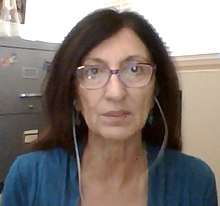Elba Serrano
Elba E. Serrano is the Regents Professor of Neuroscience at the New Mexico State University. Her research considers the role of ion channels in the reception and transduction of stimuli. She is a Fellow of the American Association for the Advancement of Science and won the Society for the Advancement of Chicanos/Hispanics and Native Americans in Science (SACNAS) Distinguished Research Mentor Award in 2015.
Elba E. Serrano | |
|---|---|
 Elba Serrano speaks at a Hypothesis Webinar in 2017 | |
| Born | |
| Alma mater | University of Rochester Stanford University |
| Awards | Presidential Award for Excellence in Science, Mathematics and Engineering Mentoring (2018) |
| Scientific career | |
| Institutions | New Mexico State University University of California, Los Angeles |
Early life and education
Serrano was born in Old San Juan.[1] Her father was a member of the United States Army and a Vietnam veteran, which meant that Serrano spent her childhood in between the Caribbean, Central America and Taiwan. She attended almost ten different schools and eventually graduated from the Nurnberg American High School.[2] She earned a Bachelor's degree in physics at the University of Rochester, where she became interested in biological and sensory processes.[3] Whilst a physics student Serrano was one of two women out of eighty students.[2] She moved to Stanford University for her doctoral degree, where she earned a PhD in biophysics under the supervision of Robert Schimke in 1983.[4] Her dissertation considered the movement of ions across the cell membrane.[5] After earning her PhD Serrano worked at Stanford University and the University of California, Los Angeles Medical School as a postdoctoral researcher. Here she became interested in the inner ear, in particular, the mechanosensory hair cells.[5]
Research and career
Serrano joined the New Mexico State University in 1992, and was made Regents Professor in 2009. Her research considers the ear, hearing and balance. She studies the formation of sensory organs and the ways nerve cells acquire their electrical phenotypes. The structure and mechanisms responsible for pressure reception and signal processing are biopolymers, transducer channels and mechanoreceptors.[3] To study these she has developed approaches to image neurons and sensory cells in vivo, primarily using multi-photon microscopy.[6]
Mentoring and advocacy
Serrano was selected as the American Association for the Advancement of Science International Lecturer on Women in Science in 2002. During this time she travelled around Brazil speaking about her experiences as a woman scientist.[1] She spent her sabbatical at the Ecole Normal Superieure, where she worked in the Laboratoire de Neurobiologie.
At New Mexico State University Serrano served as Principal Investigator of the Research Initiative for Scientific Enhancement (RISE)[7] and BP-ENDURE Building Research Achievement in Neuroscience (BRAiN) programs, which look to support students into scientific careers. From 1992 to 2018 over one hundred students have completed research projects in the Serrano laboratory, half of whom were women and over 60% are from underrepresented groups.[8] She was awarded the 2015 Society for the Advancement of Chicanos/Hispanics and Native Americans in Science (SACNAS) Distinguished Mentor award.[9] In 2018 Serrano was awarded the Presidential Award for Excellence in Science, Mathematics and Engineering Mentoring.[10][11] She has also been awarded the Alfred P. Sloan Distinguished Mentor Prize.[12] She has previously served on Francis Collins' National Institutes of Health Advisory Committee. She was also part of their Working Group on Diversity, as well as on the NIH BRAIN Initiative Neuroethics Working Group.[10][13]
In 2018 it was announced that the National Science Foundation would establish the National Resource Hub for STEM Education at Hispanic-Serving Institutions (HSI Resource Hub) at New Mexico State University.[14] HSI is led by Serrano and looks to increase the recruitment and retention of STEM students.[15]
Selected publications
Her publications include;
- Serrano, Elba E. (1988). "Red light stimulates an electrogenic proton pump in Vicia guard cell protoplasts". PNAS. 85 (2): 436–440. doi:10.1073/pnas.85.2.436. PMID 2829187.
- Serrano, Elba E. (1989). "Sensory Transduction and Electrical Signaling in Guard Cells". Plant Physiology. 91 (3): 795–799. doi:10.1104/pp.91.3.795.
References
- "Elba Serrano Page of the NSHP". www.hispanicphysicists.org. Retrieved 2019-11-02.
- "AAAS: EHR: Section Name". ehrweb.aaas.org. Retrieved 2019-11-02.
- "Elba Serrano - CDP Center". Retrieved 2019-11-02.
- "Elba Serrano | Experts Guide | NMSU News Center". newscenter.nmsu.edu. Retrieved 2019-11-02.
- Pearson (2017-04-25). Campbell Biology, 11th Ed. Bukupedia. ISBN 9780134093413.
- Serrano, Elba E.; Knight, V. Bleu (2005-04-28). "Multiphoton imaging of quantum dot bioconjugates in cultured cells following Nd:YLF laser excitation". Nanobiophotonics and Biomedical Applications II. International Society for Optics and Photonics. 5705: 225–234. doi:10.1117/12.590877.
- ReySep. 12, Camille Mojica; 2008; Am, 8:00 (2008-09-12). "Team Science and the Diversity Advantage". Science | AAAS. Retrieved 2019-11-02.CS1 maint: numeric names: authors list (link)
- "PAESMEM » Awardee Profile". paesmem.net. Retrieved 2019-11-02.
- Elba Serrano: 2015 Distinguished Award presentation, retrieved 2019-11-02
- "NMSU professor receives presidential award". NMSU News Center. Retrieved 2019-11-02.
- "OSTP and NSF to honor 140 individuals and organizations with highest US award for teachers and mentors". www.nsf.gov. Retrieved 2019-11-02.
- "2019 Jumpstart Workshop Organizers, Speakers, Facilitators DACC". HSI STEM Resource Hub. Retrieved 2019-11-02.
- "Neuroethics Working Group | Brain Initiative". braininitiative.nih.gov. Retrieved 2019-11-02.
- "NSF Award Search: Award#1832338 - Resource Hub: The NSF National Resource Hub for STEM Education at Hispanic-Serving Institutions". www.nsf.gov. Retrieved 2019-11-02.
- "NMSU selected for Hispanic-serving STEM resource hub". Las Cruces Sun-News. Retrieved 2019-11-02.
- "PeerJ - Profile - Elba Serrano". peerj.com. Retrieved 2019-11-02.